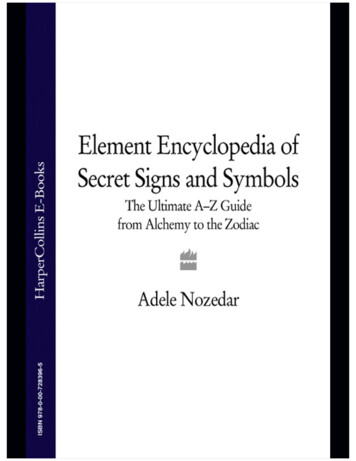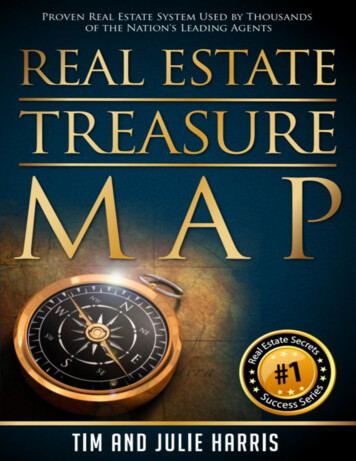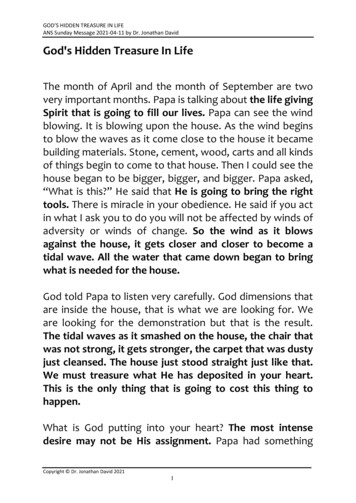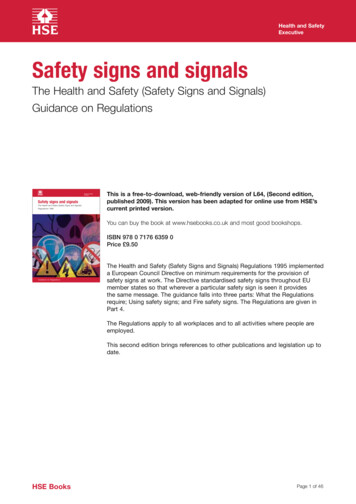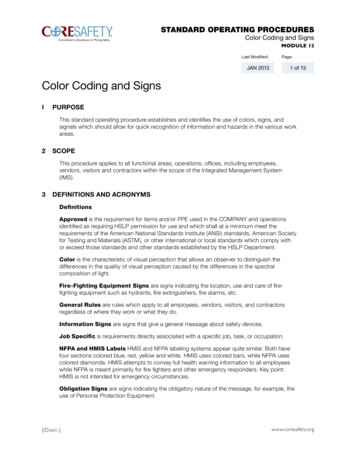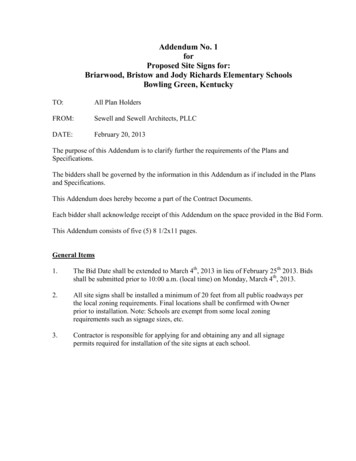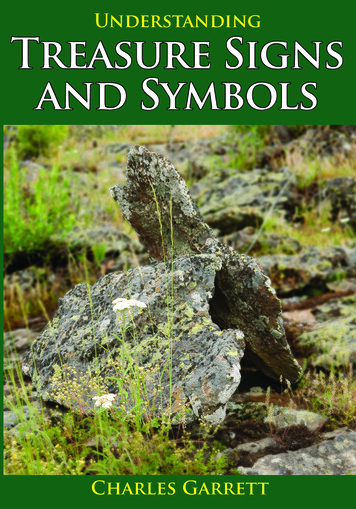
Transcription
UnderstandingTreasure Signsand SymbolsCharles Garrett
UnderstandingTreasureSigns andSymbolsCharles Garrett
Front cover photo:These boulders mark the location of a treasurehidden by an Indian tribe in the Western UnitedStates.This tribe hid its tribal wealth in a cave prior toa conflict with the federal government in the 1880s.They planned to recover the treasure after the war.This is one of several treasure markers examined inlater years in this area. Remember, when searchingfor hidden treasure signs always search diligentlyfor “out-of-place” markers. See other such markerphotos in this book.Rear cover photo:Explorers often discover ancient signs and symbolssuch as these petroglyphs on this boulder. No oneshould ever deface such precious historical works ofart.
UnderstandingTreasureSigns andSymbols
Understanding TREASURE SIGNS AND SYMBOLS Charles L. Garrett 2009Manufactured in the United States of America.All rights reserved.No part of this book may be reproduced ortransmitted in any form or by any means, electronicor mechanical, including photocopying, recordingor by any information storage or retrieval system,except in the case of brief quotations embodied incritical articles and reviews. For information, addressall inquiries to Editor, Ram Publishing Company.First printing: March 20094www.garrett.com
CONTENTSAbout the Author.7Introduction.9Early Treasure Signs.11Some Personal Experiences.15Interpreting Your Discovery.25Common Treasure Symbols.29Sun Symbols.30Distance and Measurement Symbols.31Arrows and Directional Symbols.34Compass Degree Symbols.37Treasure Direction Symbols.38Treasure Location Symbols.42Miscellaneous Symbols.50Turtle Signs and Symbols.51Snake Signs and Symbols.53Sample Tree Markings.55Moon Symbols.56Time Markings and Symbols.57Danger Symbols.58Crosses and Religious Symbols.60Spanish Treasure Terms.62Special Advice.66Other RAM Books.71Understanding Treasure Signs and Symbols5
Author Charles Garrett, seen on one of his expeditions throughArizona, regards treasure signs and symbols in the field as roadmaps to old treasure.6www.garrett.com
ABOUT THE AUTHORFor more than 45 years, Charles Garrett haspioneered the development of the modern metaldetector, demonstrated its capabilities in searches throughout the world and devoted himself toteaching others to use detectors. He has recoveredtreasures of all types while searching all over theworld. Garrett has encountered various treasuresigns and symbols in the field, some the ancientpictoglyphs of Native Americans and others suchas age-old symbology of Spanish people.The author’s lifetime interest in treasurehunting prepared him to excel in that field.After earning a Bachelor of Science Degree inElectrical Engineering, Charles Garrett worked atTexas Instruments and Teledyne Geotech developing systems and equipment required by America’sfledgling space effort. While devoting himself tohis hobby, he designed and built his own metal detectors. This avocation became a career when heand his wife, Eleanor, founded Garrett Electronicsin 1964 to manufacture and market his inventions.Understanding Treasure Signs and Symbols7
Garrett quality is praised today throughoutthe world. From the beginning, Garrett vowed“to practice what I preach” by field-testing hisequipment—to insure that each detector works forcustomers regardless of ground conditions and environment. He has become recognized as an unofficial spokesman for the hobby of treasure huntingand the metal detecting industry through a longlist of honors, personal appearances and books.This book on early treasure signs and symbolsmarks the latest installment in Charles Garrett’spocket-sized treasure hunting field guides. He isdevoted to disseminating such knowledge in aformat that is both convenient and effective forhelping individuals recover more treasure withtheir metal detectors.8www.garrett.com
INTRODUCTIONI am excited to release this fifth volumein the Garrett treasure-hunting field guideseries because treasure signs and symbols havealways been a great fascination of mine. I haveencountered these marks during my many yearsin the field and can say with experience thatunderstanding them can truly help you uncovergreat riches, just as it has helped me.Many of these early guides to treasure inthe West originated from Native Americansof North America and Spaniards exploringtheir new land. The use of such field markingsactually dates back to the beginning of mankind.Cavemen painted on cave walls with charcoalsticks. Early Europeans designed special crestsor family symbols. Ancient civilizations aroundthe globe created their own symbols for communication, identification and education.As people hid things of value, they created treasure symbols to help guide them backto their treasure trove later or to enable themUnderstanding Treasure Signs and Symbols9
to describe the location to others. Pirates andoutlaws used signs and symbols to mark theirburied booty. The outlaw Jesse James carved aparticular “J” into trees to pinpoint his caches.One such Jesse James symbol—on a section oftree that was removed and sent to me—is currently on display in Garrett’s treasure museumin Garland.There are far too many symbols and combinations of them to fully cover in this book. Iwill, however, present basic symbols, key signsand words that you may encounter in your questfor treasure. You should learn to properly interpret these symbols after you find them in orderto be successful.Your final step in recovering an old cacheis to use a high-quality metal detector that canhelp you pinpoint the coveted treasure. I trustthat this book will become another valuabletool in your treasure-hunting arsenal.I’ll see you in the field 10www.garrett.comGarland, Texas
EARLY TREASURE SIGNSMan has always concealed his treasures andother valuable possessions. People hid riches,food, weapons or even sacred burial sites. Inmany cases, such possessions were stored inremote caves, on mountainsides, under rockoutcroppings or near some geographic landmark that could later be recognized. In order torelocate their caches or describe their locationto others, individuals marked the landscape toguide them back to their stash.In some cases, this was accomplished bystacking rocks in a particular manner. NativeAmericans often bent young trees and tied themoff so that they would continue to point in aparticular direction as they matured. Such earlymonuments and trail markers were meant to appear natural to the casual passer-by. But thosewho knew what they were looking for foundtrail markings as good as a modern road map.Early tribesmen, Mayans, Incas and Aztecsused pictographs and petroglyphs to help themremember where they concealed their preciousUnderstanding Treasure Signs and Symbols11
goods. Hernan Cortes and the early Spanishexplorers were wise to learn the Indian symbolsand soon adapted some of them with Spanish variations. Some of the Indian tribes werereported by the Spanish to display vast amountsof gold, silver, pearls and jewelry—some ofwhich was doubtlessly cached away and neverrecovered. Such riches were hidden after theIndians learned that Spaniards were willing tokill them for their precious possessions.Numerous other cultures—including Spaniards, Mexicans, Egyptians, Romans, Greeksand Phoenicians—also left cryptic signs andsymbols as guides to their concealed items.These pictorial guides were carved into trees,etched or painted onto rocks or printed onanimal skins or maps. Pirates, bandits and prospectors adopted many of the same emblems.Symbols have even been used to help peoplesurvive. In the era of the Great Depression inthe United States, hobos left special symbolsto mark places that provided their greatesttreasure—life-sustaining food. Special marksdenoted where a generous person lived or the12www.garrett.com
location of a business that might offer a handout. Hobos even made symbols to warn theircompanions of a mean dog or other menaces.Those hiding treasure caches certainly didnot want to make them easy to find, so one symbol might lead the searcher to a spot where asecond symbol or map could be found. In somecases, the person hiding the goods expected notto return for years or perhaps even not at all.Yet, they wanted to leave some path that couldlead others to what they had stashed.The person hiding the treasure even neededto give himself a reminder of where to dig forhis hidden loot. Some of the symbols that wereleft behind could therefore indicate a number ofthings: the treasure itself, directions, distances,time, personal identification, landmarks or evenwarnings related to the treasure trove’s location.Florida Indians were known to carve symbols into conch shells or onto hammered-outSpanish pieces of eight. Pirates often incorporated astrological, zodiac, Masonry and evenwitchcraft symbols into their “treasure maps.”Trees were often carved with multiple symbolsUnderstanding Treasure Signs and Symbols13
and sometimes other trees or rock formationsin the same area provided additional clues. Thenavigational marks on one old tree might verywell lead to another marked tree and so on.Many symbols used in different cultureshave similar shapes and meanings. In somecases, not all symbols can be understood—particularly those where a person created a personal emblem for recognition purposes. Onlyan individual who knew a great deal aboutthat other person might be able to spot andinterpret such a personalized symbol.This field guide simply does not have thespace to cover all known treasure signs andsymbols. I will, however, present some of themore common signs that today’s treasure hunter might have the good fortune of encountering.The key to finding an old treasure cache is goodresearch and learning how to find and interpretthe clues that were left behind.14www.garrett.com
SOME PERSONAL EXPERIENCESBefore we discuss the various symbolsthemselves, I’ll relate a few of my own encounters with treasure-hunting signs and symbols.Some have led to great treasures, while othershave caused me to conduct research to decipherjust what the map symbols were saying.Javiere Castellanos, one of the author’s companions on a treasure expedition into Mexico, points to a circle on a mountainslope. Such circles served as clues, or markers, that helped leadGarrett’s team to silver caches.Understanding Treasure Signs and Symbols15
In the early 1970s, a group of men joinedme for a treasure-hunting expedition into Mexico’s Sierra Madre. We journeyed to the primitive village of Batopilas, a centuries-old goldand silver producing area. On several Batopilasarea mountains are caves perched high upon theslopes. Caves such as these were often used bytravelers and outlaws alike to hide themselvesor things they didn’t want others to find.The Garrett search team followed painted white symbols in themountains to recover these nuggets of silver ore.16www.garrett.com
We were searching for a famed silver orecache that was reportedly hidden in this mountain range. Clues were evident along the slopesof this region. Circular painted symbols hadbeen applied to the rocks as location markers leading to the treasure. We followed thesepainted symbols and, with the aid of our metaldetectors, were able to discover sacks of silverore nuggets that had been hidden in this areadecades before.Indians often marked trees to pinpoint theirtrails or to indicate directions to a treasure troveor some sacred location. The young trees whichthey bent, twisted or tied into a particular direction often grew into malformed adult trees. Inareas were trees were not available or practical for carving, Indians marked their trails orcaches in other ways.Roy Lagal—my treasure hunting buddy—and I have encountered several piles of stonesthat had been used by Indians as markers. Wehave found large rocks stacked in peculiar waysor moved into positions that could not haveoccurred naturally. Roy and I quickly learned toUnderstanding Treasure Signs and Symbols17
Indians often tied off young trees to point out a trail or the path to atreasure. Even in its old age, this deformed oak still clearly pointstoward some old trail.fire up our metal detectors when something justseemed out of place.During one expedition into old Indiancountry, Roy and I were eagerly searching anarea that offered us great hope based on ourresearch. We scoured the rugged terrain for halfan hour before we found a lucky marker.“Do you see it?” Roy yelled excitedly.It took me a couple of minutes staring in thedirection Roy was pointing—but then I saw it.18www.garrett.com
These heavy boulders, located in a fairly remote area, wereobviously propped against each other to serve as a guide. Thetreasure hunters who noticed this unnatural marker found anIndian cave cache site nearby.Understanding Treasure Signs and Symbols19
A large, flat piece of shale (similar to that shownin the photo on the preceeding page) suddenlybecame an obvious treasure marker to me. Thisparticular rock—roughly six inches thick, threefeet wide and about eight feet tall—was wedgeddown between two adjacent boulders. The rockwas left sticking up about two feet higher thanthe boulders it was wedged between. It wasclearly something unusual and out of its naturalplace.This particular area was off the beaten pathfor most people. We knew it was an old Indiansign that likely indicated a a hidden cache. Themarker led us to a small cavern tucked awayin the rocky bluffs below. The main area of thecave was void of stashed goods or treasure. Werealized that other people had been in this particular cave in recent years. (They left clues oftheir presence which were not hard to decipher.)Momentarily disappointed, Roy and I completed a thorough sweep of this cave with our metaldetectors. Our reward was finding a tomahawkand cache of weapons up on a small ledge thatthe Indians had stashed during the 19th century.20www.garrett.com
Treasure hunter George Mroczkowski studies pre-Columbian pictoglyphs in the Laguna Mountains of Southern California.Another odd rock formation led me to agreat silver cache on a treasure expedition inthe 1980s in Canada. By chance, I spotted thetop of a large rock that seemed oddly unnaturalprotruding from the ground. I scanned aroundthis rock and picked up two strong metallic signals, one on either side of the rock. After digging enough soil around this rock, I removedit and realized that it had been wedged downUnderstanding Treasure Signs and Symbols21
Mroczkowski felt that this “bursting sun” pictoglyph was an indication of a nearby buried treasure.into a hole to conceal what was under it. Sureenough, on either side of the base of this fivegallon-can-sized rock, my detector picked upnice silver readings. I soon recovered two caches of high-graded silver ore that a miner hadhidden here many decades before.The moral to both of these examples is tobe aware of your surroundings at all times andto look for things that seem out of place. Eventoday, people use signs and symbols to marktreasure caches. I recovered a decades-old coin22www.garrett.com
The author holds pieces of high-graded silver ore from two cacheshe discovered in Canada by observing a treasure sign in the field.Understanding Treasure Signs and Symbols23
cache by spotting a spike that had been drivenlong ago into an oak tree. It had been driven under the bottom side of a limb and was not easyto see. I ran my detector below where the spikewas directing me and—bingo!My advice is to keep a sharp eye out for theunnatural in your surroundings.You should also have a good understanding of the symbols outlined in this book. I’velong treasured such knowledge. An old hunting friend of mine named Bill Mahan put outa great pamphlet in 1963 called Early SpanishTreasure Signs & Symbols. I literally wore thecover off that little booklet in my many years ofconsulting Bill’s guide.I hope this guide will serve you as well.Today’s treasure hunter can also find a wealthof information about Spanish and Indian treasure symbols on the Internet.24www.garrett.com
INTERPRETING YOUR DISCOVERYThe symbols in this book are important tounderstand in order to help find your treasure.When you discover that first symbol, then thereal fun begins: the quest to solve an ages-oldchallenge!Some symbols simply will not be understood. Some will be the unique mark of theThis serpent symbol, outlined in white to highlight its details, waspresented to the author and is on display in Garrett’s treasurehunting museum in Garland, Texas.Understanding Treasure Signs and Symbols25
maker, a primitive personal logo if you will.That person’s “crest” might just be the proofthat this position is indeed the correct location.Take care to document the symbols youfind. Take a photo, if possible. Photos, however,often will not show the finite details of a symbol carved into a tree. It is therefore a great ideato sketch out the symbol you see. If the symbolis carved into a rough stone surface you mighteven be able to carefully transfer it to a sheet ofpaper by tracing the outline or lightly rubbing apencil against the paper.You can also use white poster paint or chalkto highlight or outline the symbols before youphotograph them. Do not use permanent paint!Your highlights should be easily rinsed off withwater or by nature’s next rain. Symbols shouldby treasured for the rare guideposts they are;don’t destroy them by carving or defacing themin any way.This is especially true if you encounter ancient Indian pictoglyphs on stones. Report orrecord your discovery but never destroy sucha rare piece of history. Remember the treasure26www.garrett.com
This old tree section contains a specific “J” symbol that was reportedly used by the outlaw Jesse James to mark an area wherehe had hidden a cache. This symbol, again highlighted in white toshow the detail, is also on display in Garrett’s museum.Understanding Treasure Signs and Symbols27
hunter’s code of ethics which we should all follow as responsible searchers. Simply put, I’vealways preached that you should leave a placein better condition than you found it.Check out the area around the location ofany treasure symbol. Draw a map of the area,marking any symbols you find along with precise distances and directions between them andnearby landmarks. Take note of these significant landmarks—rivers, creeks, old trees, rockformations, etc. Try to research this area to findwho might have left these signs.Use your metal detector to search the areawhere the treasure clues seem to be steeringyou. If you can’t find anything, study your mapand its symbols again.28www.garrett.com
COMMON TREASURE SYMBOLSMany signs and symbols can have multiplemeanings—an important fact to consider asyou attempt to interpret an old drawing or map.Some early Indian pictographs—which can befound in all parts of the United States—simplycannot be interpreted. Many, however, are quiteclear and point toward the location of an item orwhere an event once happened.Spaniards later used some of the same earlyIndian signs and symbols with only slight variations. While space limits the volume of suchsymbols that can be discussed, I will begin bycovering some of the more commonly encountered treasure glyphs.Sun SymbolsA circular sun may often be found with various accompanying signal clues. For example, asetting sun would indicate that you should looktoward the west.Understanding Treasure Signs and Symbols29
MINE, TREASUREBELOWBELOW, VAULTDESCENDINGEARLY EXAMPLETHE SETTING SUN,SUNOF SUN, WINDLASS,LOOK WESTEARLY EXAMPLEMINE, TREASUREOF SUN, WINDLASS,BELOW, VAULTMINE, TREASURETHE EARLY EXAMPLEDESCENDINGDOF SUN, WINDLASS,SUNMINE, TREASUREASCENDING BELOW, VAULTEARLY EXAMPLETHETHE SUNSUNTHE SUNASCENDINGOF SUN, WINDLASS,DESCENDINGSUNMINE, TREASURESUNDBELOW, VAULTTS,SUN GODTHE SUNASCENDINGTHE SUNSUNSUNDESCENDINGSUN SUN LARGE QUANTITYSUN, MINERALSINGSUN SIGNOF MINERALS,SUN SIGN CLOSE BYSUN SIGN BRIGHTPROSPECTS,BRIGHT PROSPECTS,SUN GODGOLD SIGNDESCENDINGBRIGHT PROSPECTS,THE SUNOPENINGOPENINGGOLD, TREASUREOPENINGSUNSUN, TIME, LIGHT,NEARBYOPENING, AIRSUN SIGN THE SUNBRIGHT PROSPECTS,SUN GODSUN SIGN OPENINGBRIGHT PROSPECTS,OPENINGGOLDGOLD, TREASURELARGE QUANTITYGOLD, TREASURESUN, TIME, LIGHT,NEARBYOF GOLD,LARGE QUANTITYSUN SIGN OPENING, AIRGOLDSIGNECLIPSE,GOLD,LOOK EAST,ECLIPSE,GOLD,LOOK WESTINGODTHE SHADOWOF MINERALS,GHT PROSPECTS,SUNIN THE SHADOWCOUNT NO.IN GOLDTHE SHADOWOFTHESUNSIGNOPENINGOF THE SUNOF RAYS DAYSOFTHESUNGOLD, TREASUREN SUN, TIME, LIGHT,NEARBYGOLD, TREASURESPECTS,SUN GODOPENING, AIRECLIPSE, GOLD,NEARBYNG IN THE SHADOWECLIPSE, GOLD,OF THE SUNIN THE SHADOWOF THE SUNGOLD, TREASUREEARLY EXAMPLESUN, MINERALSTHE SETTING SUN, NEARBYSUN, TIME, LIGHT,OF SUN,CLOSEBYWINDLASS,LOOK WESTOPENING, AIRCLIPSE, GOLD,MINE, TREASURETHE SETTINGSUN,THE SHADOW GOLD, TREASUREBELOW,LOOKWESTVAULTOF THE SUNSUN, TIME, LIGHT,NEARBY30 www.garrett.comOPENING, AIRGOLD,ADOWSUNT NO.S DAYS11BELOW, VAULTSun Symbols
Distance and Measurement SymbolsThe Spanish word “vara” was an early measurement of distance used by land surveyors. Avara measured 33 inches or about the normalstride of a Spanish soldier. Another commonSpanish land measurement was the league. Theland measurement of a league varied from 2.12to 2.18 miles.Estado was a term used to indicate the minimum depth that items of importance were to beburied, set at 5 feet 7 inches. Pirates and sailorsalso used the term braza to indicate a depth of5’7” for treasure. On their maps, the pirate replaced the term braza with paces or varas. Atall man’s pace could be significantly differentfrom that of a short man; but the pirate knew touse the braza distance of 5’7” for each vara orpace distance indicated on a map.Understanding Treasure Signs and Symbols31
UTES,100 VARASVARAS6 ETC.DISTANCEDISTANCE6 FEET, 6 VARAS,6 MINUTES,6 ETC.3 KILOMETERSDistance and Measurement SymbolsCONTINUATION OF,6 FEET, 6 VARAS,4 DEGREES,6 FEET, 6 VARAS, 4 DEGREES,DISTANCEON CORRECT4 VARAS6 MINUTES,6 ETC.4 MINUTES,6 MINUTES, 6 ETC.4 MINUTES,LINE,3 VARASINCHESOR SECONDSS,CONTINUATIONOF,4 ETC., CAVE4 ETC., CAVES,OR CAVES, ON CORRECTOR CAVES, 4 VARASVEFINGERMINERALS LINE, 3 VARASMINERALS4 DEGREES,INCHES OR SECONDSS,MEANS ONE4 MINUTES,4 VARAS4 VARASS4 ETC., CAVEINCHES OR SECONDSOR SECONDSOR CAVES,TRIPLE DISTANCEMINERALSCONTINON CLINE4 DEGREES,CONTINUATIONOF,4 VARAS,4 VARAS,2 VARAS,TRIPLE6 FEET,4 MINUTES,ONTOCORRECT6TOFEET,6 VARAS,4 ETC. TO RIGHT4 ETC.RIGHT6 VARAS,2 ETC.DISTANCELEFT2E6MINUTES,6 ETC.4ETC.,CAVELINE,3VARASAS,6 MINUTES, 6 ETC.2 VARAS,OR CAVES,O RIGHT2ETC.TOLEFT6FEET,6VARAS,MINERALS 6 FEET, 6 VARAS,4 VARAS,6 MINUTES, 6 ETC.6 MINUTES, 6 ETC.4 ETC. TO RIGHT6 FEET, 6 VARAS,6 FEET, 6 VARAS,6 FEET, 6 VARAS,6 FEET, 6 VARAS,6 MINUTES, 6 ETC.6 MINUTES, 6 ETC.6 MINUTES, 6 ETC.6 MINUTES, 6 ETC.3 KILOMETERS3 KILOMETERS4 VARAS,2 VARAS,4 DEGREES,CONTINUATION OF,DISTANCE2 ETC. TO LEFTETERS4 ETC. TO RIGHT4 MINUTES,ON CORRECT4 ETC., INCAVELINE, 3 VARAS5 VARAS5 VA4DEGREES,CONTINUATION OF,3KILOMETERSOR CAVES,4 VARASDIRECTION4 MINUTES,ON CORRECT DIREDSOFMINERALSPOINT5 VARAS IN4 ETC., CAVEDEGREES,OF, OFGREES,ON4 BOTTOMCONTINUATIONCONTINUATIONOF, LINE, 3 VARASDIRECTIONON BOR CAVES,4 MINUTES,NUTES,ON CORRECT ON CORRECTOF POINT FINGERFINGERMINERALSCAVE., CAVE 4 ETC.,LINE, 3 VARAS LINE, 3 VARASONBOTTOMMEANSONE DISTANCETRIPLEOR CAVES, DISTANCEMEASUREMENT MEANS ONECAVES,3 KILOMETERSMINERALS50 VARASERALSE4 VARAS,(33.3 INCHES),TRIPLE2 VARAS,FINGER4DISTANCEETC. TO RIGHTSOMETIMES 2 ETC.TO LEFTTRIPLEMEANSONE100 VARAS5 VARAS DISTANCEIN4 VARAS,2VARAS,6FEET,6VARAS,RAS,DIRECTION4 ETC. TO RIGHT2 ETC. TO LEFT6 MINUTES, 6 ETC.6 ETC.OF POINT4 VARAS,4 VARAS, TRIPLE2 VARAS,2 VARAS,DISTANCEON BOTTOM4 ETC. TO RIGHTC. TO RIGHT2 ETC. TO LEFT2 ETC. TO LEFTFINGERMEANSONE32 www.garrett.com14&153 KILOMETERS3 KILOMETERS
MINUTE ORFEETDISTANCE2 VARASINCHES ORSECONDSDistance and Measurement SymbolsINCHES OR2 VARASSECONDS4 TIMES DISTANCE,5 VARAS TO LEFT,FOLLOW POINT,5 SECONDS OR4 VARAS5 INCHES TO LEFT.5 VARAS TOSONRY SIGH 5 SECONDSRAS, FOLLOW5 INCHESINCHES OR5 VARAS TO LEFT,MINUTE ORINCHESOR TOOF TRIANGLESMASONRYSIGH 5SECONDSORSECONDSSECONDSM WITH 4 MARKSFEET4 VARAS,MASONRY SIGH 5 INCHES TOLEFT. FOLLOWPOINT OF TRIANGLES4 VARAS, FOLLOWH OR ARM WITH 4 MARKSPOINT OF TRIANGLES5 VARAS TO LEOWOR ARM WITH 4 MARKS5 SECONDS OLES5 INCHES TO LARKSUP 4 FEET ORONE FINGE4 VARASMASONRY SIGH ONE VAR4 VARAS, FOLLOWFOLLOW DIRE4 TIMES DISTANCE,5 VARAS TO LEFT,POINTOF TRIANGLESUP 4 FEETORFOLLOW POINT,5 SECONDS ORVARASOR ARMWITH 4 MARKS4 VARAS4 VARAS5 INCHES TO LEFT.4 TIMES DISTANC2 VARASFOLLOWPOINT,5 VARAS TO LEFT,5 VARASTOTIMES DISTANCE,4 VARAS54 SECONDSOR5 SECONDFOLLOWPOINT,5 INCHES TO LEFT.5 INCHES T4 VARASSTIMASONRY SIGH 4 VARAS, FOLLOW4 TIMES DISTANCE,POINT OF TRIANGLESHAND WITHFOLLOW POINT,STILL FARTHER2 VARAS3 FINGERS OR ARM WITH 4 MARKS4 VARAS3 VARAS, 3 ETC.,ONE FINGER AND HAND DIRECTION POINTERHAND WITHONE VARA, ONE ETC.,3 FINGERS4 TIMES DISTANCE,FOLLOW DIRECTION OF FINGE3VARAS,3ETC.,FOLLOW POINT,FEET ORONE FIN4 VARASARAS DIRECTION POINTERONE VAONE FINGERANDHAND FOLLOW DIUP 4 FEETORONE VARA,ONE ETC.,4 VARASUP 4 FEET OR 4 TIMES DISTANCE,4 TIMES DISTANCFOLLOW DIRECTION OF FINGER4 VARASFOLLOW POINT,FOLLOW POINT2 VARAS4 VARAS4 VARASUnderstanding Treasure Signs and Symbols 33ONE FINGEONE VARFOLLOW DIREUP 4 FEET ORSTILL FARTHER4 VARAS2 VARAS
ARROWSENEMY, DIRECTION,OR TO OTHER SIGNS3ETO TREASURArrows and DirectionalSymbolsARROWSFOLLOWTOTOTREASURE,TO WATERTO WATERENEMY, DIRECTION,MARKThe arrow was NEXTa verycommonsymbolthatOR TO OTHER SIGNSindicates the direction or distance necessary toTO TREASURE,travel toward something.TO WATER5 ENEMIESES, DIRECTION,OTHER SIGNS3 ENEMIES5 ENEMIESTO TREASTO WAT3 ENEMIESDOWNWARD TOARROWSENEMY, DIRECTION,DOWNWARD5 ENEMIES DOWNHILL TOTREASUREBELOW,TO TREASURE,ORTOOTHERSIGNSFOLLOW TODOWNHILLLOOKBELOW TO TREASURE3 ENENEXT MARKDOWNWARD TO TREASURE,DOWNHILL TO TREASURETO TREASURE,TO WATEROKTO TREASURE, DOWNWARDTO WATERDOWNHILLEMIESFOLLOW TONEXT MARK5 ENEMIESFROM TREASURE,3AWAYENEMIESAWAY FROM NEXT SIGNTREASURE BELOW,LOOK BELOWBELOW,LOWDOWNWARD TO TREASURE,DOWNHILL TO TREASUREDIVIDEDFOLLOW TOTREASURENEXT MARKTO TREASUTO WATERDIVIDETREASUDIVIDEDTREASURETO TREASURE,TREASURE TO ONESIDEDOWNWARDTO TREASURE,TO WATERDOWNHILL TO TREASURE DIVIW TOTREASURE WRONSURE,WRONG DIRECTION DOWNHILL TOAWAY FROM NEXT SIGNFOLLOW TOSIGNNEXT MARKTREASURE BELOW,34 www.garrett.comLOOK BELOWOM TREASURE,WRONG DIRECTIONOM NEXT SIGNDIVIDED4&5
ISE,PWRONG DIRECTIONTOWARD THE SUN,TOWARDS THE MOONArrows and HERE, THIS ISA LANDMARKLOOK BELOWTHE PLACE,OR RIVER,TOWARD THE DS THE MOONARROWSTOWARDS THE MOONTO THE RIGHTOF THE TRAILOR LANDMARKTREASUREIN THEWOODSSTRAIGHTACROSSA LANDMARK,HERE, THIS ISOR RIVER,THE PLACE,OR ROADCIRCLE AROUND,AWAY FROM TREASURE,FRIENDSHIPLOOK AROUND YOUAWAY FROMNEXTSIGNSTRAIGHT ACROSSHERE, THIS ISA LANDMARK,TOWARDTHE SUN,DEFEAT, DEATHTHE PLACE,ORRIVER, THE MOONTOWARDSCIRCLE AROUND,CIRCLE OK AROUNDA LANDMARK,TO THE RIGHTPROCEED,ORRIVER,OF THE TRAILTHEN TURN RIGHTOR ROADOR LANDMARKTOWARD THE SUN,TOWARDS THE MOONTREASURE TO ONE SIDEDEFEAT, DEATHCIRCLE AROUNDTOWARD THE SUN,LOOK AROUND YTOWARDS THE MOONTO THE RIGHTOF THE TRAILTOWARD THE SUN,ORPROCEED,LANDMARKTHE MOON BENEATH THE WATERSBOX BELOWTHEN TURN RIGHT TOWARDSBOX BELOWBOX BELOWDEFEAT, DEATHCIRCLE AROUND,LOOK AROUND YOU4&5TO THE RIGHTOF THE TRAILWARRIORS,CIRCLEAROUND,ORLANDMARKDEATHLOOK AROUND YOUTO THE RIGHTPROCEED,OF THE TRAILTHEN TURN RIGHTBELOWCIRCLE AROUND,Signs and Symbols BOX35WARRIOROR LANDMARKUnderstanding TreasureWARRIORS,SBENEATH THE WATERS LOOK AROUND YOUDEATHDEATH
“ WARD OFF EVIL SPIRITS” TOWARD THE CENTER“PROTECTS”,DIRECTIONCHANGETOWARD THE CENTERArrows and Directional SymbolsHEROVER ANDGO AROUND,REVERSE,TO THE LEFTADIRECTIONDIRECTIONCHANGECHANGEDIRECTION, WATER NEARBY,HERE,LOOK UP, ALERTNESSTO WATER, TO CREGO AROUND,OVER AND UNDERDIRECTIONRIVER, STREAM, OCPOINTS GETHELEFTOVER AND UNDERWATER NEARBY,TO WATER, TO CREEK,“WARDOFFEVILSPIRITS”DIRECTION,RIVER, STREAM, OCEANPOINTS TO,“PROTECTS”,FROM, LIGHTING LOOK UP, ALERTNESSTOWARD THE CENTERDIRECTION,“ WARD OFF EVIL SPIRITS”LOOKUP, ALERTNESSDIRECTION“PROTECTS”,CHANGETOWARD THE CENTERDIRECTIONCHANGEDIRECTIONCHANGEARROWSPOINTS TO,FROM, LIGHTINGGO AROUND,REVERSE,TO THE LEFTGO AROUND,DIRECTIONREVERSE,POINTS TO,CHANGETO THE LEFTFROM, LIGHTING36www.garrett.comDIRECTION,LOOK UP, ALERTNESSDIRECTIONCHANGEWATO WRIVERDIRECTIONCHANGEHERE,OVER AND UNDERWATER NEARBY,HERE,TO EAM, OCEAN“ WARD OFF EVIL SPIRITS”“PROTECTS”,TOWARD THE CENTER
Compass Degree SymbolsSome old maps will contain symbols ofcompassdegreesto SEXTILEhelp steeryou
This book on early treasure signs and symbols marks the latest installment in Charles Garrett’s pocket-sized treasure hunting field guides. He is devoted to disseminating such knowledge in a format that is both convenient and effective for helping individuals recover m
